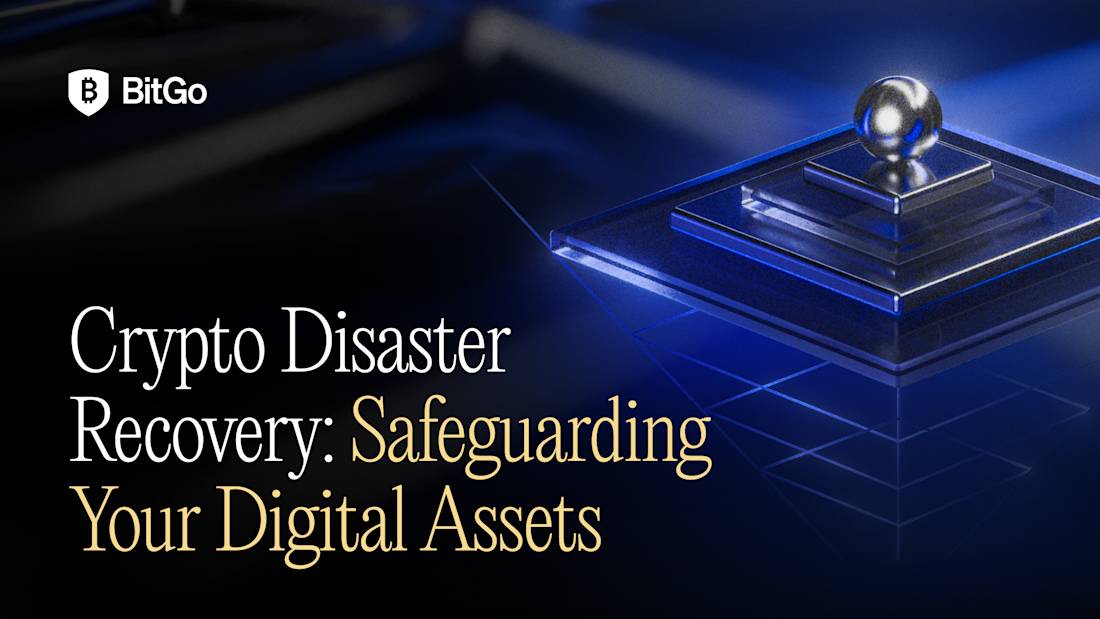Institutions today face ever-growing pressure to strengthen their digital asset security against a wide range of risks, from cyberattacks and operational errors to regulatory missteps. That’s where crypto disaster recovery comes in.
Rather than waiting for something to go wrong, forward-thinking organizations build proactive recovery plans to ensure business continuity and protect their reputation. A strong recovery strategy is a foundational component of institutional crypto risk management.
Key Takeaways
-
A crypto disaster recovery plan provides institutions with a structured framework for restoring lost or inaccessible digital assets.
-
Proactive planning reduces downtime, prevents asset loss, and supports compliance with regulatory frameworks.
-
Key elements of a disaster recovery plan include backups, access protocols, insurance, and custody partnerships.
-
Identifying operational and technical risks, such as key loss or cyberattacks, is essential to building a resilient response.
-
Disaster recovery strengthens overall institutional crypto risk management frameworks and builds stakeholder trust.
What Is Crypto Disaster Recovery?
Crypto disaster recovery refers to the strategies, technologies, and policies that organizations use to recover access to digital assets after disruptive incidents. These incidents might include cyberattacks, hardware failure, human error, or key compromise—basically, any event that results in asset inaccessibility or loss.
Because digital asset ownership is defined by control of private keys, loss of access often means irrecoverable loss of funds, which makes disaster recovery a critical part of operational security.
It involves preventive planning, secure backup mechanisms, access restoration procedures, and business continuity measures tailored to the unique challenges of the digital asset ecosystem.
Organizations can’t rely on traditional IT recovery models alone; digital assets require custom approaches that account for blockchain technology’s decentralized nature.
Why Organizations Need Disaster Recovery
The need for crypto disaster recovery is operationally and financially urgent. Institutions handling digital assets are entrusted with safeguarding vast amounts of value, often on behalf of clients, partners, or investors.
-
Preventing Financial Loss: The most immediate risk of not having a recovery plan is financial fallout. Without a recovery mechanism, a misplaced private key or a compromised wallet could mean losing millions.
-
Preserving Reputation: Trust is everything in financial services. A single high-profile breach or asset loss can cause long-term reputational harm. Having a disaster recovery plan demonstrates a commitment to client protection.
-
Ensuring Regulatory Compliance: As regulators tighten oversight of digital assets, institutions must demonstrate risk mitigation procedures and business continuity plans to meet crypto regulation compliance standards.
-
Strengthening Fraud Prevention: Recovery planning also supports efforts in crypto fraud prevention. By mapping access controls and detection mechanisms, organizations can identify fraudulent activity early.
Types of Crypto Disasters and Risks
Organizations operating in the digital asset space face an array of risks that can compromise access to digital assets. Unlike traditional systems, blockchain transactions are irreversible, which means even small mistakes can lead to permanent loss.
A solid crypto disaster recovery plan should begin by addressing the most common threat scenarios:
-
Private Key Loss or Mismanagement: Losing access to private keys, whether through human error, deletion, or technical failure, can make digital assets unrecoverable.
-
Cyberattacks and Ransomware: Hackers often target wallets and infrastructure. A successful breach can drain funds or lock institutions out of critical systems.
-
Insider Threats: Unauthorized access or malicious behavior of employees can bypass internal controls and result in asset loss or data exposure.
-
Infrastructure Failures: System outages, server crashes, and software bugs can prevent timely access to wallets or transaction execution.
-
Physical Disasters: Hardware wallets and cold storage can still be affected by theft, fire, or natural disasters, especially if backups aren’t in place.
The collapse of Mt. Gox, which led to the loss of approximately 850,000 Bitcoins, is a lasting reminder of what can happen when organizations overlook disaster recovery. These risks highlight the urgency of strengthening Bitcoin security through robust planning.
Key Components of a Crypto Disaster Recovery Plan
A well-structured recovery plan takes time to build. It must integrate with the institution’s broader technology stack, legal obligations, and business processes.
Here are the foundational components of a strong crypto disaster recovery strategy.
Secure Crypto Backup Strategy
A comprehensive crypto backup plan includes encrypted digital copies of all wallets, keys, and critical configuration data. These backups should be maintained in geographically distributed environments, using cold storage and access-quarantined systems to prevent tampering.
Automated backup scheduling, secure key sharding (splitting a private key into multiple parts), and access version control are increasingly seen as best practices in the institutional space. These measures help ensure that even in the event of a breach or system crash, key data is safely restored.
Access Controls and Multi-Signature Protocols
Central to disaster prevention and recovery is minimizing the risk of single-point failures. Multi-signature wallets, which require multiple approvals to move assets, significantly reduce the likelihood of theft or mismanagement.
Institutions should also implement layered access protocols that include:
-
Role-based permissions
-
Biometric authentication
-
Time-locked transactions
-
Real-time alerting for abnormal activity
Incident Response Playbooks
When disaster strikes, minutes matter. An incident response playbook outlines step-by-step procedures for containing, assessing, and responding to different threats. This includes clearly defined roles, decision-making authority, escalation paths, and legal contacts.
Simulated breach drills or tabletop exercises can help organizations assess the strength of their playbooks and make continuous improvements.
Custodial and Infrastructure Partnerships
Qualified custodians play a pivotal role in recovery planning. They offer not just storage solutions but also infrastructure that includes transaction policy engines, whitelisting tools, and real-time wallet management interfaces.
BitGo, for example, provides regulated crypto custody that is both compliant and operationally flexible, enabling institutions to meet risk requirements without compromising speed or control.
The Importance of Institutional Crypto Risk Management
A well-defined crypto disaster recovery plan is vital to a broader institutional risk management framework. As digital assets become more integrated into financial systems, institutions must account for operational risks as well as regulatory and reputational ones.
Disaster recovery strategies should align with larger governance protocols, asset protection models, and compliance expectations. From wallet security to multi-layered access controls, risk management must be comprehensive and forward-looking.
Partnering with a regulated custodian, such as BitGo, ensures compliance with industry standards while providing secure infrastructure, transaction policy controls, and contingency mechanisms designed for institutional scale.
BitGo’s approach to institutional crypto risk management incorporates regulated custody, policy-driven wallet configurations, end-to-end insurance, and customizable recovery procedures. With these controls, institutions can manage digital assets with confidence.
FAQ
What is crypto disaster recovery?
A crypto disaster recovery strategy helps organizations restore access to digital assets following unexpected events like cyberattacks, key loss, or technical failures. It includes tools such as secure backups, access controls, and third-party custodians.
Why is disaster recovery important for crypto assets?
Digital asset recovery is often irreversible if the assets are lost or stolen. Recovery planning is essential for maintaining business continuity and client trust. Without it, even small missteps can lead to permanent losses.
What methods are available for recovering lost crypto assets?
Recovery methods include restoring encrypted backups, using multi-signature wallets with redundant key holders, and relying on qualified custodians who can facilitate access in line with governance policies.
What are the risks of not having a disaster recovery plan for cryptocurrency?
Organizations without a recovery plan risk financial loss, compliance penalties, reputational harm, and business interruption. The decentralized nature of digital assets can make it unforgiving to those who don’t take the necessary precautions when investing in the space.
Table of Contents
The latest
All NewsAbout BitGo
BitGo is the digital asset infrastructure company, delivering custody, wallets, staking, trading, financing, and settlement services from regulated cold storage. Since our founding in 2013, we have been focused on accelerating the transition of the financial system to a digital asset economy. With a global presence and multiple regulated entities, BitGo serves thousands of institutions, including many of the industry's top brands, exchanges, and platforms, and millions of retail investors worldwide. For more information, visit www.bitgo.com.
©2025 BitGo, Inc. (collectively with its parent, affiliates, and subsidiaries, “BitGo”). All rights reserved. BitGo Trust Company, Inc., BitGo, Inc., and BitGo Prime LLC are separately operated, wholly-owned subsidiaries of BitGo Holdings, Inc., a Delaware corporation headquartered in Palo Alto, CA. BitGo does not offer legal, tax, or investment advisory services. The statements contained herein are only intended for marketing and informational purposes and should not be interpreted as legal, tax, or investment advice. Please consult your legal,tax,investment, or other professional advisor for questions about your specific circumstances. Digital asset holdings involve a high degree of risk, and digital asset values may fluctuate on any given day. Accordingly, your digital asset holdings may be subject to large swings in value and may even become worthless. The information provided herein is not intended for distribution to, or use by, any person or entity in any jurisdiction or country where such distribution or use would be contrary to law, statute, or regulation. BitGo is not directing this information to any person in any jurisdiction where the publication or availability of the information is prohibited, by reason of that person’s citizenship, residence, or otherwise. The information contained in our press releases, blogs, and presentations should be considered accurate only as of the date of the press release, blog, or presentation. We disclaim any obligation to supplement or update the information in these press releases, blogs, or presentations, except as may be required by law. Product availability and client eligibility will vary by jurisdiction. Services listed may be provided by one of BitGo's affiliated entities.




